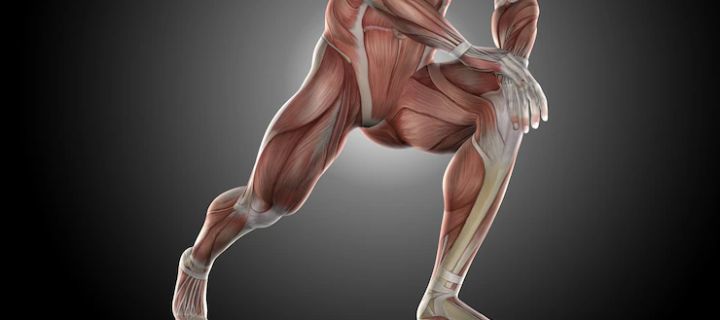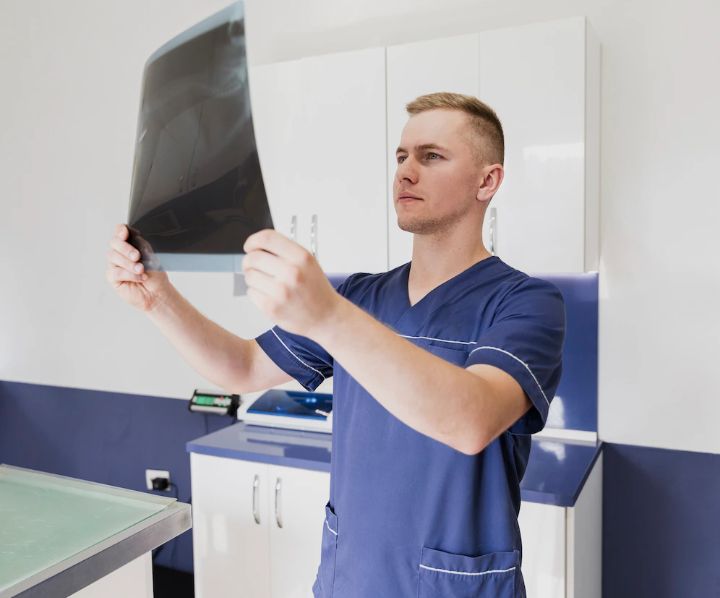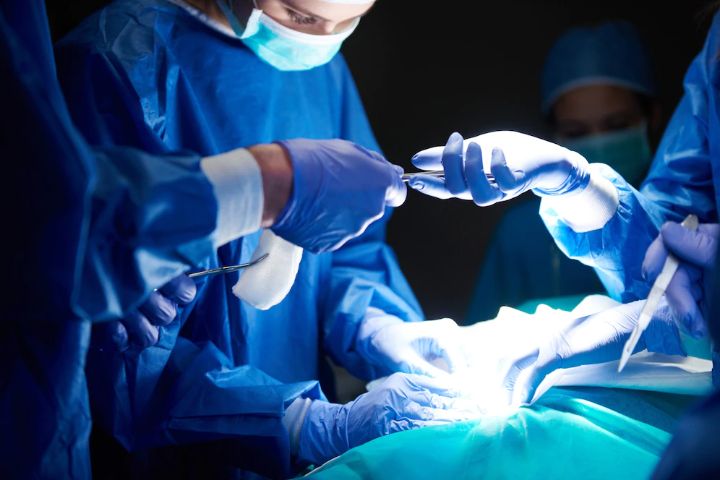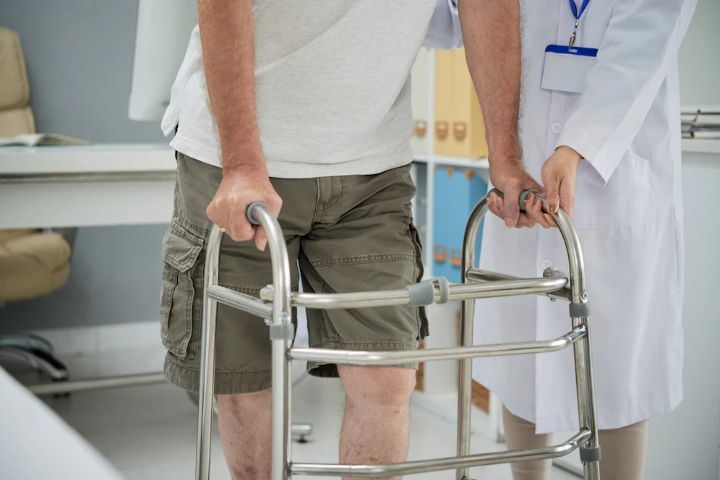A groin strain is a common injury that affects the adductor muscles of the inner thigh. It is often associated with a sudden movement or change of direction during physical activity, particularly in sports that involve running, jumping, or kicking.
Groin strain can cause significant pain and discomfort and may limit an individual’s ability to perform daily tasks and participate in their chosen activities.
Groin strain is a common injury that occurs when the muscles in the groin area are stretched or torn. It is often referred to as a pulled groin, adductor strain, or hip strain. The groin muscles are a group of muscles that attach the thigh bone to the pelvis and allow for movement of the hip joint.

Photo Credit: kjpargeter
Groin strain can occur in athletes, especially those who participate in sports requiring sudden direction changes or jumping, such as soccer, basketball, or football.
A groin strain is often caused by sudden movements or overuse of the groin muscles. Activities that involve sudden changes in direction or twisting of the hips can put the groin muscles under stress, leading to strain or tear. Poor conditioning, improper warm-up, and muscle imbalances can also increase the risk of groin strain.
A groin strain is a common injury that can occur to anyone, particularly athletes who engage in sports that require sudden changes in direction, jumping, or kicking. The symptoms of groin strain can vary depending on the severity of the injury, but the most common sign is pain in the groin area.
The pain may range from mild to severe, and it may be accompanied by swelling or bruising in the affected area. Individuals with groin strain also experience difficulty moving their legs, especially when moving the leg away from the body. This movement, called abduction, stresses the injured muscles and can cause pain.
In addition to pain and swelling, individuals with groin strain may experience stiffness in the groin area, which can limit their mobility and range of motion. The stiffness can make it difficult to perform daily activities such as walking, sitting, or standing.
If you suspect that you have a groin strain, it is essential to seek medical attention promptly. Delaying treatment may worsen the injury and prolong your recovery time. Healthcare professionals can diagnose the injury accurately and provide proper treatment to help you heal quickly.
Diagnosing groin strain involves a physical examination and medical history to determine the cause of the injury and the extent of the damage. The healthcare provider may ask about the individual’s symptoms, including the location and severity of the pain and any activities that aggravated the injury.

Photo Credit: Freepik
During the physical examination, the healthcare provider may assess the affected area’s range of motion and strength. In some cases, imaging tests such as ultrasound, MRI, or X-ray may be required to confirm the diagnosis and rule out other potential injuries such as a hernia or stress fracture.
When treating groin strain, the primary goal is to relieve pain, reduce swelling, and restore mobility. Different treatment options may be recommended depending on the injury’s severity. Here are some of the most common:
The RICE method is a simple yet effective way to treat groin strain. Resting the injured area helps prevent further damage, while ice can reduce pain and inflammation. Be sure to wrap the ice in a towel or cloth to avoid direct skin contact and apply it to the affected area for 10-20 minutes at a time, several times a day.
Compression is another way to reduce swelling and promote healing. You can use an elastic bandage or compression shorts to pressure the injured area gently. Elevating the leg can also help to reduce swelling.
Physical therapy may be recommended to help strengthen the affected muscles and improve flexibility. A physical therapist can work with you to develop an individualised treatment plan that includes exercises and stretches to help speed up recovery.
Your doctor may prescribe pain medication or anti-inflammatory drugs to help manage pain and reduce swelling. Be sure to follow the dosage and usage instructions carefully.
Surgery may be necessary to repair a severe groin strain in rare cases. This may be recommended if non-surgical treatments are ineffective or if the muscle has a complete tear.

Photo Credit: gpointstudio
If you suspect you have a groin strain, it’s important to seek medical attention as soon as possible. Your healthcare provider can recommend the best treatment options for your specific needs.
Groin strain is a common injury that can significantly impact an individual’s physical activity. However, there are ways to prevent this injury from occurring in the first place.
Before engaging in any physical activity or sport, it is crucial to warm up the muscles in the groin area properly. This can be achieved through gentle stretching exercises that target the adductor muscles responsible for pulling the legs together.
In addition to warming up before physical activity, it is also essential to incorporate stretching routines into your daily routine. This can help improve flexibility and reduce the risk of muscle strain.
Regular exercise and strength training can help improve overall muscle strength and flexibility, reducing the risk of groin strain.
By incorporating these preventative measures into your daily routine, you can significantly reduce the risk of a groin strain and confidently enjoy your physical activities.
Recovering from groin strain can take time and requires patience and commitment. If you try to return to physical activity too soon, you could end up re-injuring yourself and prolonging the recovery process.

Photo Credit: pressfoto
After the initial acute phase of the injury, which typically lasts 48 to 72 hours, you should gradually introduce gentle stretching exercises to help loosen the muscles and increase flexibility. Avoid any activities that cause pain or discomfort; always listen to your body.
Physical therapy can play a critical role in the recovery and rehabilitation process. A qualified physical therapist can assess the extent of your injury and develop a tailored treatment plan to help you regain strength, mobility and flexibility.
Your physical therapy program may include exercises to strengthen the muscles in your groin, hips and core, manual therapy and other forms of therapeutic intervention.
Before returning to physical activity, it is important to seek clearance from your healthcare provider and to reintroduce activity in a controlled manner gradually. Often, a phased return-to-play program is recommended to gradually increase the intensity and duration of physical activity while carefully monitoring your progress.
Addressing any muscle imbalances or weaknesses contributing to your injury is also important. A physical therapist or sports medicine professional can help identify and correct these issues to help prevent future injuries.
A: Groin strain refers to an injury of the muscles in the groin area, specifically the adductor muscles. It occurs when these muscles are stretched beyond their limits or torn due to sudden movements or excessive stress.
A: Common symptoms of groin strain include groin pain, swelling, bruising, and difficulty in moving the leg or hip. The severity of the pain may vary depending on the extent of the injury.
A: Groin strain is typically diagnosed through a physical examination and medical history assessment. In some cases, additional tests such as imaging studies or ultrasound may be required to confirm the diagnosis and assess the severity of the injury.
A: Treatment options for groin strain include rest, ice, compression, and elevation (RICE), which help reduce pain and swelling. Physical therapy, exercises, and medication may also be recommended to promote healing and improve muscle strength and flexibility.
A: Preventing groin strain involves proper warm-up exercises, stretching routines, and maintaining muscle strength and flexibility. It is also important to gradually increase the intensity and duration of physical activity and seek professional guidance when necessary.
A: Recovery and rehabilitation for groin strain involves resting the injured area, gradually resuming physical activity under professional guidance, and following prescribed exercises and therapies to regain strength and prevent re-injury.